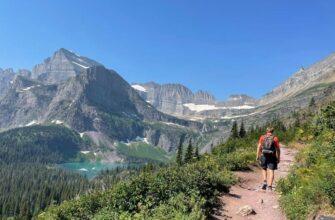Autumn is the perfect time to get out and explore the changing colors of nature, but don’t forget to wear appropriate hiking clothes (rain jacket, wool socks, hiking leggings, etc.)!
Hiking in fall can be tricky because temperatures vary so the key is to layer your outfit (base layer, mid layer, and outer layers) so you can control how much (or how little!) warmth you need.
The right shoes are also essential as they can make or break your hike. Don’t know what to wear hiking in fall? The most important details in this text are the tips and tricks on what to wear and what kind of shoes to wear while hiking in the Fall.
The author will share their favorite picks for maximum comfort from leggings to flannels.

- What to wear when hiking in fall: fall hiking outfit
- What to wear hiking in fall: best hiking pants for autumn weather
- What to wear hiking in fall: the best fall hiking boots
- Waterproofing
- Comfort & fit
- Lightweight
- What to wear hiking in fall: types of jackets for fall and rainy weather
- Convertible jackets
- Softshells
- Rain shells
- What to wear hiking in fall: choosing the right fabric for your fall hiking clothes
- What to wear hiking in fall: setting yourself up with a comfortable and trendy fall hiking outfit
- What to wear hiking in fall: merino wool base layers
- Benefits of merino wool fall hiking clothes:
- Hiking socks
- Outer layers: fall hiking
- Fall-friendly fabrics
- Features to look for
- Down jackets and insulated jackets
- Down jackets
- Insulated jackets
- Headwear, gloves, and other accessories
- Hat
- Scarf
- Balaclava
- Gloves
- Trekking poles: yes or no?
- Base layers for hiking in fall
- Synthetic or merino fabric
- Breathability
- Comfort
- Mid-layer for fall hiking
- Waterproof hiking boots and rain pants
- FAQs
- What do you wear hiking in 40 degrees?
- What pants to wear hiking in the fall?
- What jacket to wear hiking in autumn?
- What to wear hiking in 30-40-degree weather?
- Conclusion
What to wear when hiking in fall: fall hiking outfit
So, what to wear hiking in fall? Fall hiking is one of the best outdoor activities during the autumn season. To maximize your experience, it is important to consider the type of shoe and clothing.
Hiking boots are a great option for cooler weather, as they have good support and waterproofing capabilities.
Hiking outfits should be made of lightweight fabrics that will keep you warm but won’t cause you to overheat.
Wicking materials like polyester or wool will help draw moisture away from your skin while layering items like a base layer, jacket, and vest can provide insulation while keeping weight minimal.
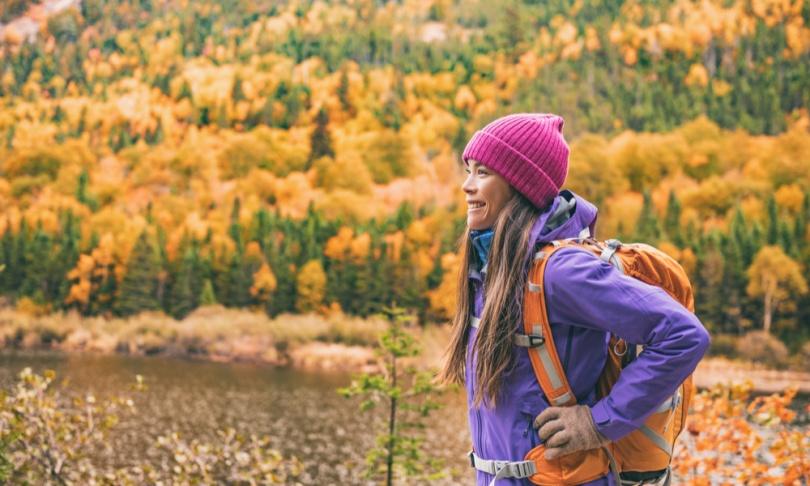
What to wear hiking in fall: best hiking pants for autumn weather
The most important piece of hiking outfits for fall hiking trips is pants. Opt for lightweight cotton or synthetic hiking pants with adjustable waistbands, a gusseted crotch, and a water-resistant coating to ensure protection from the elements.
For added warmth, consider hiking pants with built-in leg zippers or stirrups, and extra pairs of socks for extra coverage. With the right gear and planning, you’ll be ready to tackle any trail this autumn.
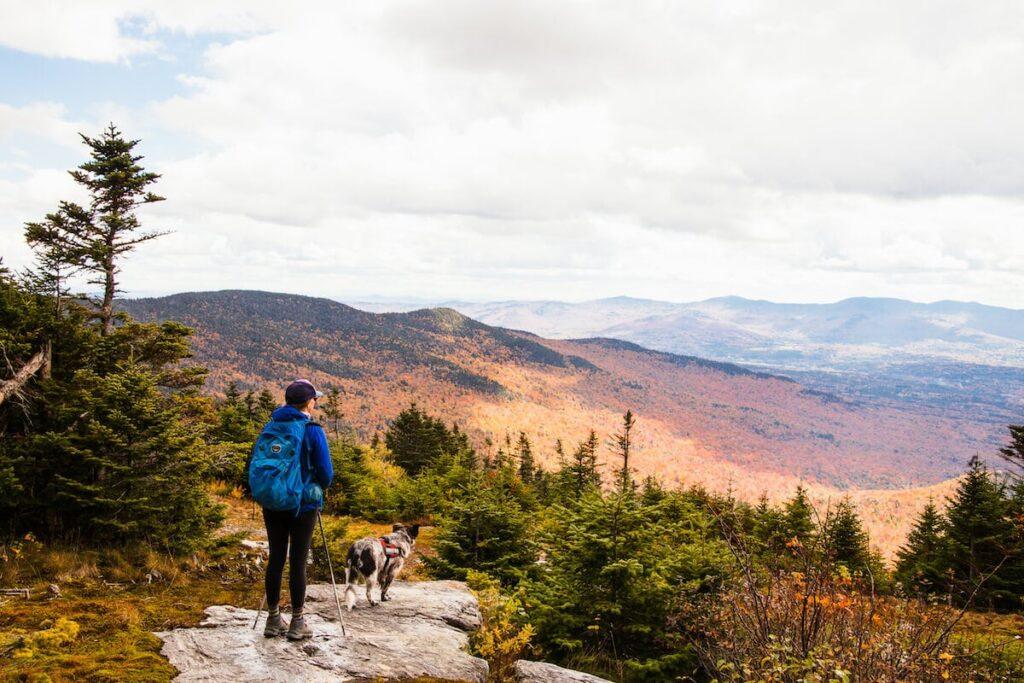
What to wear hiking in fall: the best fall hiking boots
When selecting the best hiking boots for autumn, it is important to look for something waterproof, comfortable, and light. These features should be considered when selecting fall hiking shoes.
Waterproofing
In fall, it is important to look for waterproof materials and construction that will keep moisture out and feet dry.
Many brands design their shoes with waterproofing technology that can be combined with wool socks.
Comfort & fit
A good fit is essential for finding the perfect pair of shoes for a day on the trails in the fall. Look for features like cushioning and padding to provide extra support and breathability, as well as lacing systems that make it easy to adjust them.
Lightweight
Lightweight shoes with breathable materials like breathable mesh or durable suede provide comfort and provide comfort while trekking in autumn weather.

What to wear hiking in fall: types of jackets for fall and rainy weather
When the temperature starts to drop, jackets become must-have hiking clothes in your wardrobe. Not all of us are lucky enough to have sunny, mild weather when it comes time to go on a hike.
That’s why having the right jacket can make all the difference.
Here are some of my favorite types of jackets for fall and rainy weather.
Convertible jackets
A convertible jacket is a great option for those looking for protection from wind and rain, as it can be unzipped or unsnapped to create a vest.
It is lightweight and packable, making it easy to carry in a backpack if needed.
Softshells
Softshells are two or three layers of fabric with water-resistant properties to keep you warm and dry on the trails. They are best for dry hikes that require basic wind protection.
Rain shells
A rain jacket protects you from moisture, like drizzle or even heavy downpours, while blocking out wind at the same time. Rain shells are made of synthetic or waterproof fabric with a breathable inner layer to keep sweat and moisture away from the body.
They also come with adjustable hoods, pockets, cuffs, and zips for added convenience and comfort.

What to wear hiking in fall: choosing the right fabric for your fall hiking clothes
When it comes to your fall hiking outfit, the fabric makes the outfit! When choosing a fall hiking outfit, consider factors such as breathability, moisture-wicking properties, and water repellency.
Synthetic materials are great for wicking away sweat, while natural fabrics like cotton or wool are good for breathability and insulation.
Below are some fabrics that are typically used in best hiking clothes:
- Nylon. Great for fast-drying moisture-wicking performance. It’s also lightweight, quick-drying, and durable.
- Polyester. Highly durable and breathable, making it perfect for breathable layers. It’s also highly resistant to fading and shrinking.
- Wool. Natural fibers like wool can be great at keeping you warm in cold temperatures while still providing insulation when it’s too warm out. Wool is also naturally water-repellent and will wick away moisture if you sweat during the fall hike.
The fabric of hiking clothing should be tailored to the environment you are in, such as lightweight synthetic materials for humid climates, heavier layers with wool or other natural fibers for colder climates, and extra warmth, body heat, and insulation against the elements.

What to wear hiking in fall: setting yourself up with a comfortable and trendy fall hiking outfit
Good news — it is possible to look cool, and still be comfortably dressed for fall hiking. To strike the perfect balance between comfort and fashion, start with these basics:
- A long-sleeved shirt. You want something breathable and stretchy, preferably made from performance or merino wool or a synthetic fabric like polyester. This will keep you cool and help wick away moisture if you get too warm.
- A lightweight jacket or pullover. Look for water-resistant ultra-light jackets that offer the perfect amount of insulation.
- Comfortable trousers. Softshell trousers are a great option as they are lightweight, breathable, and water-resistant.
- Hiking shoes. Look for shoes that have a good grip to ensure that you don’t slip on wet rocks or twigs. Also, shoes made with waterproof material like Goretex will keep your feet dry in case of rain or puddles.
- A sun hat. It’s important to keep your head covered in the sun, so make sure you have one that can be easily folded up when not needed.
Once you’re wearing the right clothes for your hike, make sure that you also have enough hydration and snacks with you — it will make all the difference during your fall adventure!

What to wear hiking in fall: merino wool base layers
Merino wool is a great material for fall hiking, as it is lightweight yet provides excellent warmth and insulation, for example, merino wool hiking socks. It is also made from natural fibers and is breathable, making it perfect for when you start to work up a sweat.
Benefits of merino wool fall hiking clothes:
- Lightweight. Merino wool is incredibly light, making it easy to carry around with you on your hike.
- Breathable. Merino wool can regulate your body temperature and wick away moisture from sweat so that you remain comfortable throughout your hike.
- Durability. Merino wool is also incredibly durable so it will last for many seasons of hikes and outdoor activities.
- Easy care. Merino wool garments don’t need to be washed after every wear, making them great for those who are constantly on the go!

Hiking socks
Hiking socks are an essential part of hiking gear, and there are a variety of materials, durability levels, and thickness options to choose from.
When selecting the right pair for you, it is important to consider the temperature and type of hike.
Cotton socks may feel comfortable but provide little warmth in cold temperatures, while merino wool or synthetic materials may be more expensive but can keep your feet warm and dry.
For long hikes, cushioned socks with moisture-wicking technology are essential. Investing in quality pairs of hiking socks is critical if you want your feet to stay comfortable along the way.
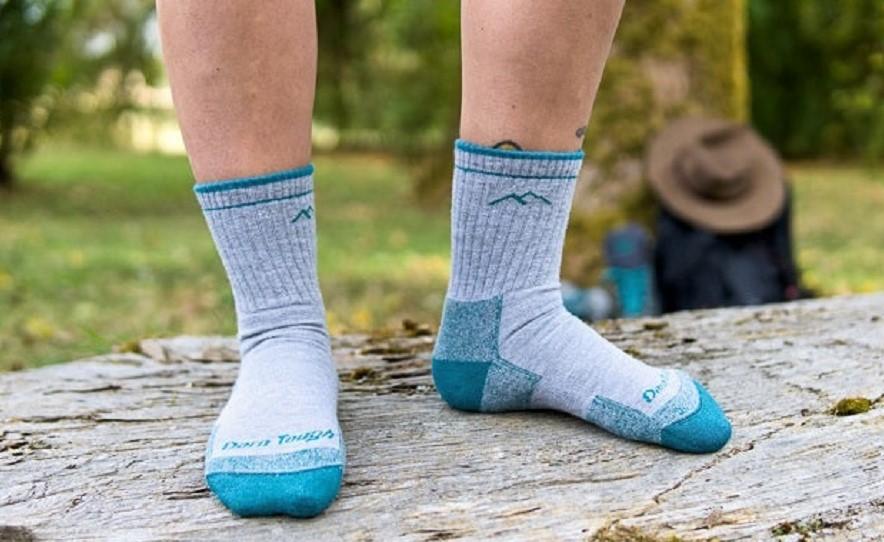
Outer layers: fall hiking
Your outer coating is an important part of what to wear for hiking in the fall. It’s essential to pick something that meets both your needs and keeps you warm as the weather gets cooler. Think about what activities you’re going to be doing and plan accordingly.
Fall-friendly fabrics
Look for fabrics that have natural insulation, such as wool or down, that can help keep you warm and comfortable while outdoors.
Synthetic fabrics like polyester or nylon are also a great way to stay dry and keep the chill away! Avoid cotton, as it feels cool and gross when wet, which isn’t ideal in chilly weather.
Features to look for
Be sure your outer coating includes details such as adjustable hoods or cuffs that help block out wind and rain, while pockets are useful for keeping items at hand.
Drawstring waists or hems can help seal out drafts and zip collars offer extra warmth when necessary. Choosing a jacket that has water resistance is also a great idea if rain is in the forecast.
Finally, be sure to pick something lightweight so you don’t feel weighed down when hiking.

Down jackets and insulated jackets
The cooler temperatures of fall are perfect for a lightweight jacket. Down and insulated jackets are going to be your best friend, keeping you warm while also providing enough breathability to keep you comfortable on your hike.
Down jackets
A down jacket is great for hiking in autumn because it is both lightweight and extremely warm. These jackets use either duck or goose down to provide insulation that traps warmth, while still being light enough to wear as an outer layer.
Another bonus is that down is highly compressible, meaning that it takes up far less space in your pack than a synthetic insulated jacket.
Insulated jackets
Insulated jackets provide a similar warmth to down jackets but usually tend to be slightly heavier. While synthetic materials don’t have the same loft as down, they differ in one key area – durability.
Insulated jackets will be more resistant to water, making them ideal for wet climates or adventures involving a lot of precipitation.

Headwear, gloves, and other accessories
Unless you’re hiking in a warm environment, it’s important to wear the right headwear and gloves in the fall. When temperatures start to drop and summer comes to an end, you should be prepared with the basics: a hat, scarf, or balaclava, and some lightweight gloves.
Not only will they keep you warm while hiking in colder temperatures, but they’ll also help protect you from the elements. Here are some of the best accessories to keep you warm:
Hat
A good hat is essential for any outdoor activity. Not only will it keep your head warm, but it also shades your face from the sun when temperatures get high during the day. A good hat should be breathable and lightweight so that it won’t slow you down as you hike.
Scarf
A thick scarf is great for keeping your neck and upper body warm during chilly days out on the trail. Look for a lightweight scarf that can be easily packed away if temperatures start to rise during your hike.
Balaclava
A balaclava is great if you need extra warmth on a cold day or if you plan on spending time outdoors after dark (e.g., star-gazing). The material should be breathable so that it won’t cause overheating while keeping your face covered against wind and chill.
Gloves
Gloves are also important when spending time outdoors in autumn. Look for wool or synthetic gloves that are water-resistant and can provide warmth without weighing you down as you move around.
It’s essential to have these items with you when heading out into colder weather conditions – after all, who can endure nature elements without proper clothing?

Trekking poles: yes or no?
Trekking poles are essential for outdoor journeys, providing stability, self-defense, comfort, and protection against wild animals.
They help prevent slipping and sliding on tricky surfaces, spread out the weight load, and reduce stress on hips, knees, and ankles. If you have extra space in your pack, it is worth bringing a pair along for the ride.
Base layers for hiking in fall
The base layer of clothing worn while hiking in the fall is essential for keeping you warm and dry. It should be made from moisture-wicking fabric that won’t add too much bulk or weight and should be worn together in different combinations.
A vest or jacket over a long-sleeve shirt and pants is often the best option, and the right socks are essential for staying warm and dry in cold weather. Here are some tips on what to look for when picking out the base layer:
Synthetic or merino fabric
These fabrics offer great breathability and temperature regulation so they’re perfect for active pursuits like hiking.
Synthetic materials are usually lightweight, making them ideal for packing up and taking on the trail with you. Merino wool offers natural wicking properties, plus it’s super soft, so that makes it great for layering too!
Breathability
The last thing you want is to be stuck wearing sweat-soaked layers on a chilly autumn day – make sure your base layers allow air to flow freely through them so that moisture evaporates quickly.
Look out for products with ventilation vents built into them as this will help with keeping your body temperature regulated throughout your hike!
Comfort
Finally, comfort is key – no matter what the weather might throw at you during your hike, make sure that your base layer will not be too tight or loose.

Mid-layer for fall hiking
If you want to be super comfortable, mid-layers are the way to go when your hike takes you out into chillier weather. Mid layers are designed to keep your core warm, while still allowing you to move freely and stay active during your hike.
There are plenty of options when it comes to choosing mid-layers, but my personal favorites include:
- Fleece jackets or vests
- Softshell jackets
- Insulated jackets
- Baselayers (short sleeve T-shirt)
- Down or synthetic insulated jackets
These lightweight fabrics are perfect for providing just enough protection and warmth, without weighing you down or making you feel confined.
They come in a variety of colors and styles, so it’s easy to find something that fits your hiking needs and style. Plus, all of these items can be layered beneath an outer layer for extra warmth on colder days.
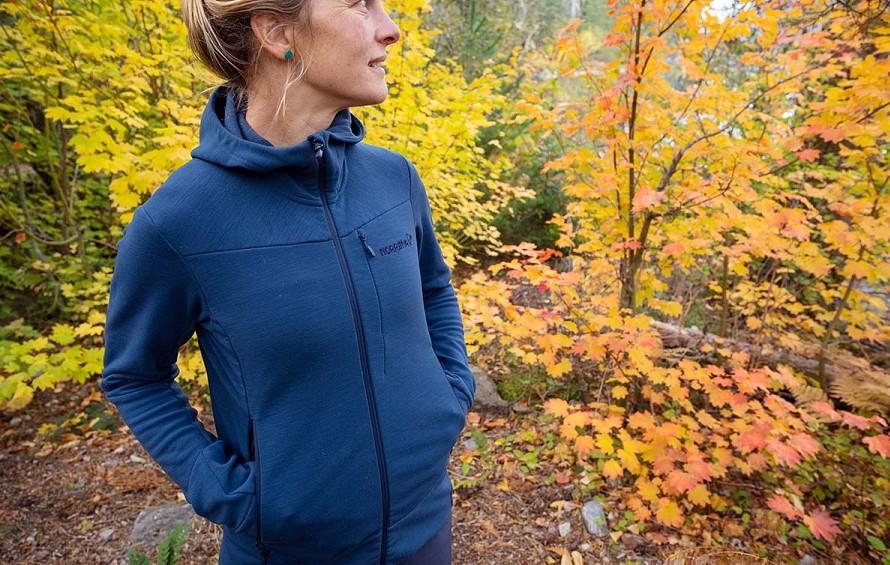
Waterproof hiking boots and rain pants
It is important to be prepared for rain during fall hikes with the right gear, such as waterproof hiking boots, good-quality hiking socks, and rain pants or shell pants.
Waterproof boots should have a rubber toe cap and a reliable tread pattern, and the upper part of the boot should be waterproofed with a membrane or coating.
These pants should fit loosely and protect against the elements and should be lightweight, breathable, and durable.
So make sure to include water-resistant items in your Fall hiking packing list! Here’s what you’ll need:
- Waterproof hiking boots
- Rain pants or shell pant
- Rain jacket

FAQs
What do you wear hiking in 40 degrees?
On walks in temperatures below 40 degrees Fahrenheit, an insulating layer of polyester microfleece, quilted down, or polyester fill, or a wool vest or wool shirt, will help keep the chill at bay.
What pants to wear hiking in the fall?
Autumn hiking pants. Comfortable, lightweight, waterproof, water-resistant pants can suffice for any fair-weather occasion. If it is cold, you can wear layered bottom layers underneath your pants. When there is heavy rain it is possible to wear rain pants.
What jacket to wear hiking in autumn?
Synthetic jackets are ideal for most of the country’s typical fall weather. They breathe much better than down and continue to insulate effectively when wet, making them an excellent outer layer for chilly (and occasionally damp) weather.
What to wear hiking in 30-40-degree weather?
There’s just time for preparations. During a hike in 30-degree conditions, you will need three layers. We recommend wearing an ideally warm base to absorb moisture and insulation layers such as fleeces or insulated outer layers for the outdoor activities of hiking.
Conclusion
Fall is a great season to hike, but it is important to choose the right gear and clothing. Choose a lightweight, breathable base layer and mid layer, as well as waterproof hiking boots or pants, to stay comfortable and enjoy the spectacular views of the foliage and crisp air.
Remember, the most important thing is to stay safe and have a great time.
Also Read About: What To Wear For Your First Dayhike



![What is considered a long hike? [8 factors to consider] What Is Considered A Long Hike: Top 3 Tips & Best Guide](https://griffithparkhiker.com/wp-content/uploads/2024/01/griffithparkhiker-2-335x220.jpg)

